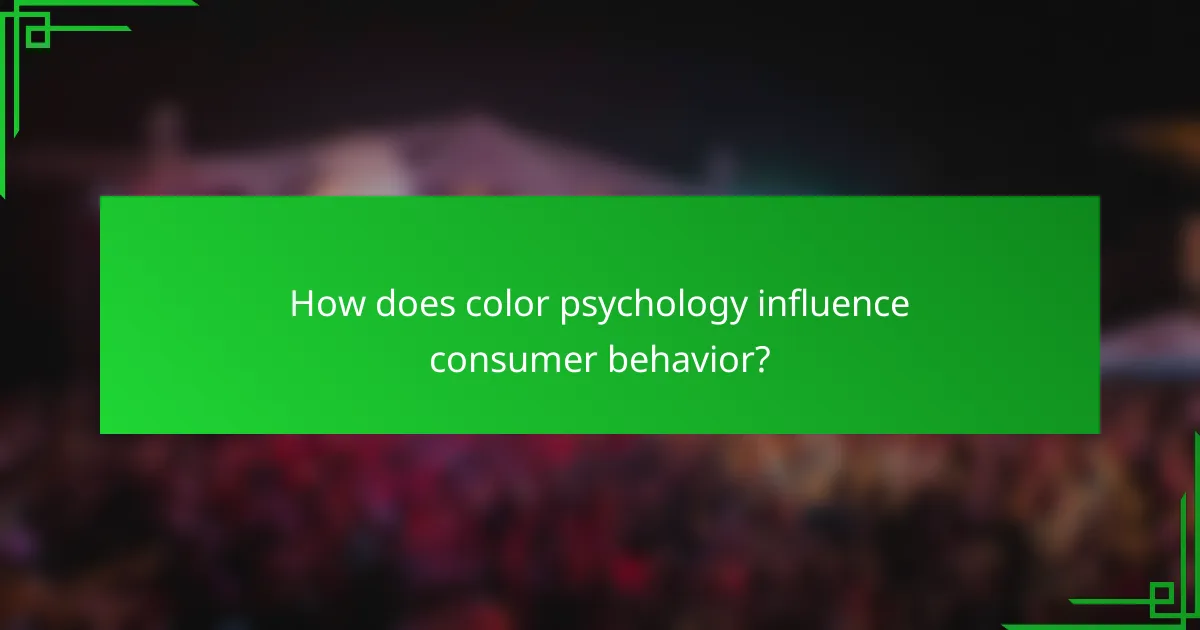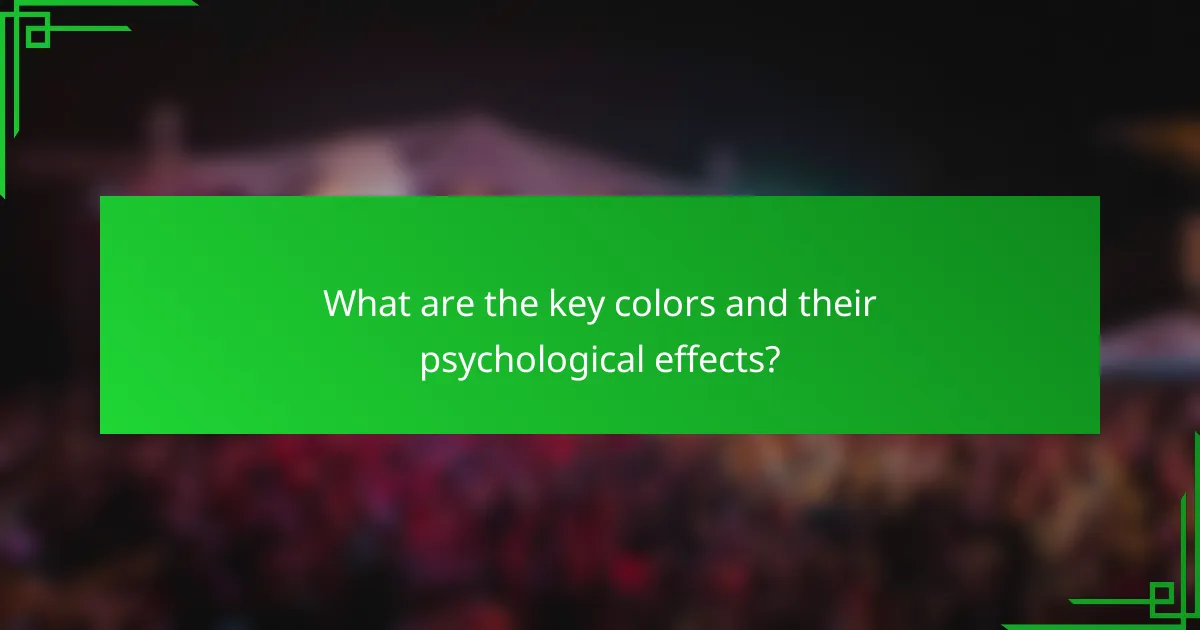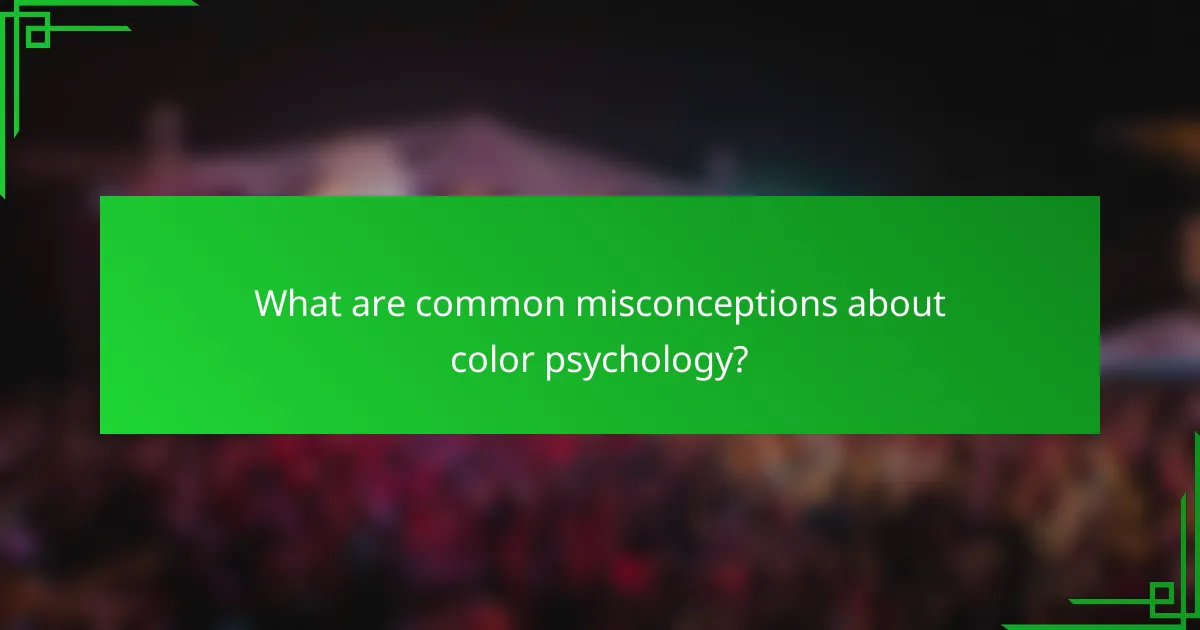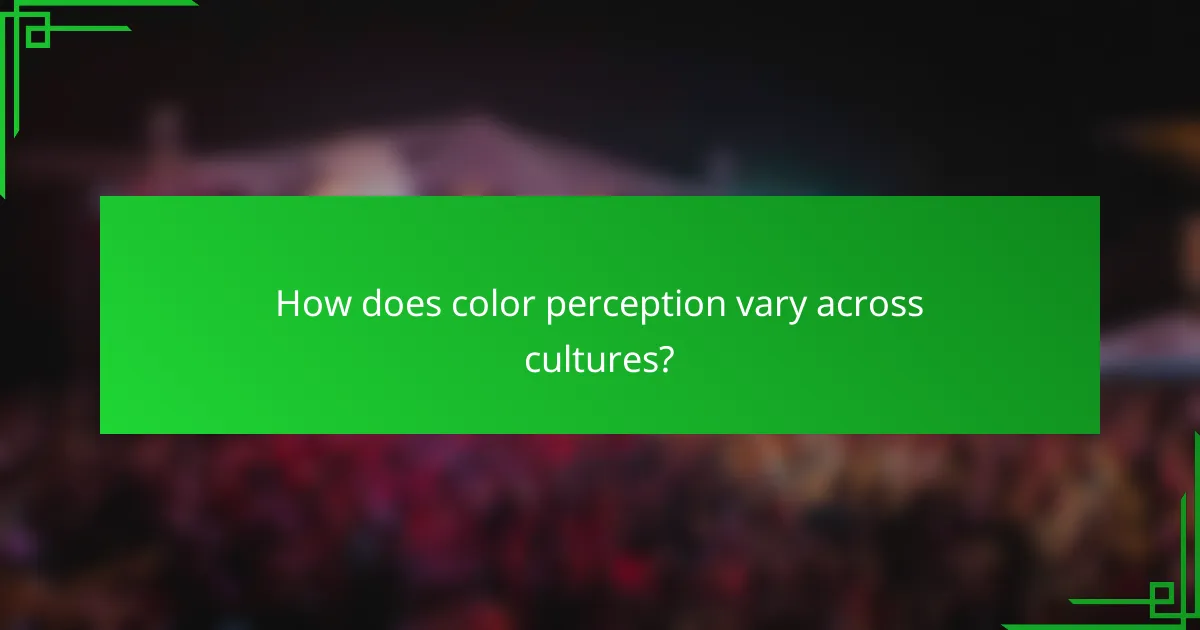Color psychology plays a crucial role in shaping consumer behavior by influencing emotions and perceptions, which can significantly impact purchasing decisions. By understanding how different colors evoke specific feelings and associations, businesses can strategically select colors to enhance marketing strategies, improve brand recognition, and ultimately drive sales.

How does color psychology influence consumer behavior?
Color psychology significantly impacts consumer behavior by affecting emotions and perceptions, which can ultimately influence purchasing decisions. Different colors evoke specific feelings and associations that can drive consumers toward or away from products.
Emotional responses to colors
Colors can elicit strong emotional responses that vary by culture and individual experiences. For instance, red often stimulates excitement and urgency, making it a popular choice for clearance sales. In contrast, blue tends to evoke feelings of calmness and trust, which is why many financial institutions use it in their branding.
Understanding these emotional triggers allows marketers to strategically select colors that align with the desired consumer experience. For example, using green can promote a sense of health and sustainability, appealing to eco-conscious buyers.
Color associations with brands
Brands often use specific colors to create a recognizable identity and convey their core values. For example, McDonald’s uses red and yellow to evoke feelings of happiness and appetite, while Coca-Cola’s red is synonymous with excitement and energy. These associations help consumers quickly identify and connect with brands.
Consistent use of color in branding can enhance brand recall and loyalty. Companies should consider how their color choices align with their brand message and target audience to strengthen their market presence.
Impact on purchasing decisions
Color can significantly influence purchasing decisions, with studies suggesting that up to 90% of snap judgments about products are based on color alone. For instance, a product’s packaging color can affect perceived quality and value, impacting whether a consumer decides to buy it.
To optimize sales, businesses should test different color schemes in their marketing materials and product designs. A/B testing can reveal which colors resonate best with target demographics, leading to more effective campaigns and higher conversion rates.

What are the key colors and their psychological effects?
Colors significantly influence human emotions and behaviors, shaping perceptions and choices in various contexts. Understanding the psychological effects of key colors can enhance marketing strategies, design choices, and personal interactions.
Red: urgency and excitement
Red is often associated with urgency and excitement, making it a powerful color in marketing and design. It can stimulate quick decision-making, which is why it’s frequently used in clearance sales and promotions.
When using red, consider its intensity; brighter shades can evoke more excitement, while darker reds may convey a sense of sophistication. Be cautious, as excessive use can lead to feelings of aggression or anxiety.
Blue: trust and calmness
Blue is linked to feelings of trust and calmness, making it a popular choice for corporate branding and healthcare settings. This color can create a sense of security and reliability, encouraging consumers to feel comfortable with their choices.
In design, lighter shades of blue can evoke tranquility, while darker shades may convey professionalism. It’s advisable to balance blue with warmer colors to avoid a cold or detached atmosphere.
Green: health and tranquility
Green represents health and tranquility, often associated with nature and renewal. This color can promote a sense of balance and harmony, making it ideal for wellness brands and eco-friendly products.
When incorporating green, consider using various shades to convey different messages; for example, bright greens can suggest freshness, while deeper greens may imply stability. Avoid overwhelming designs with too much green, as it can become monotonous.
Yellow: optimism and attention
Yellow is a color that embodies optimism and attention, often used to grab attention in advertising. It can evoke feelings of happiness and energy, making it effective for brands aiming to inspire positivity.
However, excessive yellow can lead to feelings of anxiety or frustration, so it’s best used as an accent color rather than a primary one. Pairing yellow with complementary colors can enhance its effectiveness while maintaining visual balance.

How can businesses apply color psychology in marketing?
Businesses can effectively apply color psychology in marketing by strategically selecting colors that evoke specific emotions and associations in their target audience. This approach can enhance brand recognition, influence consumer behavior, and ultimately drive sales.
Choosing brand colors
When selecting brand colors, consider the emotions and perceptions associated with different hues. For example, blue often conveys trust and reliability, while red can evoke excitement and urgency. Aim for a color palette that aligns with your brand values and resonates with your target demographic.
Conducting market research can help identify which colors appeal to your audience. A/B testing different color schemes can also provide insights into which combinations yield better engagement and conversion rates.
Designing product packaging
Product packaging should reflect the brand’s identity while utilizing color psychology to attract consumers. Bright colors may stand out on shelves, while muted tones can suggest sophistication. Consider how colors can differentiate your product from competitors and appeal to your target market.
Incorporating color contrasts can enhance readability and draw attention to key information, such as product benefits or pricing. Ensure that the color choices are consistent with your overall branding to create a cohesive look.
Creating effective advertisements
Effective advertisements leverage color psychology to capture attention and convey messages quickly. Use colors that align with the emotional tone of your campaign; for instance, warm colors can create a sense of urgency, while cool colors may promote calmness and trust.
Test different color combinations in your ads to see which ones resonate best with your audience. Keep in mind that cultural differences can affect color perception, so tailor your color choices to the specific markets you are targeting.

What are the best practices for using color in e-commerce?
Effective use of color in e-commerce can significantly enhance user experience and drive sales. Best practices involve selecting appropriate color schemes, testing variations for conversion rates, and strategically using colors in call-to-action buttons.
Color schemes for website design
Choosing the right color scheme is crucial for website design as it influences user perception and emotional response. A harmonious palette that aligns with your brand identity can create a cohesive look and feel. Common schemes include complementary, analogous, and triadic colors, each offering unique visual impacts.
For e-commerce, consider using warm colors like red and orange to evoke excitement, while cooler colors like blue and green can instill trust and calmness. Tools like Adobe Color or Coolors can help generate effective color combinations tailored to your brand.
Testing color variations for conversion
Testing different color variations is essential to determine which combinations yield the highest conversion rates. A/B testing allows you to compare two or more color schemes to see which performs better in terms of user engagement and sales. Aim for a sample size that provides statistically significant results.
When testing, focus on key elements such as backgrounds, text, and buttons. Changes in color can lead to noticeable differences in user behavior, so monitor metrics like click-through rates and purchase conversions closely.
Using colors in call-to-action buttons
Call-to-action (CTA) buttons should stand out to encourage user interaction. Use contrasting colors that draw attention while still fitting within your overall color scheme. For example, if your site has a predominantly blue palette, a bright orange or green CTA can effectively capture attention.
Additionally, consider the psychological implications of color. Red can create a sense of urgency, while green often signifies safety. Test different colors for your CTAs to see which resonates best with your audience and leads to higher conversion rates.

What are common misconceptions about color psychology?
Common misconceptions about color psychology include the belief that colors have fixed meanings and that these meanings are universally applicable. In reality, color perception is influenced by a variety of factors, including individual experiences and cultural contexts.
Overgeneralization of color meanings
One major misconception is that each color has a specific, universally accepted meaning. For example, while red is often associated with passion or danger, its interpretation can vary widely depending on context. In marketing, red may evoke urgency, while in a cultural setting, it might symbolize celebration.
This overgeneralization can lead to ineffective communication or branding strategies. It’s crucial to consider the specific audience and context when applying color meanings, rather than relying on broad assumptions.
Cultural differences in color perception
Cultural backgrounds significantly influence how colors are perceived and interpreted. For instance, while white is commonly associated with purity in Western cultures, it can represent mourning in some Eastern cultures. Such differences can impact design choices and marketing messages.
When targeting a global audience, it’s essential to research cultural associations with colors to avoid misinterpretation. Engaging local experts or conducting market research can provide valuable insights into how colors are perceived in different regions.

How does color perception vary across cultures?
Color perception can differ significantly across cultures due to various factors such as traditions, environmental influences, and societal norms. These differences can impact how colors are interpreted and the emotions they evoke in different cultural contexts.
Regional color preferences
Regional color preferences often reflect the local environment and cultural heritage. For instance, in many Western cultures, blue is commonly associated with calmness and trust, while in some Eastern cultures, it may symbolize immortality. Understanding these preferences can help in tailoring marketing strategies and design choices to resonate with specific audiences.
In Africa, vibrant colors like red and yellow are frequently favored, representing energy and vitality. In contrast, Scandinavian countries tend to prefer muted tones, reflecting their minimalist design aesthetic. Recognizing these regional differences is crucial for effective communication and branding.
Symbolism of colors in different cultures
Colors carry distinct meanings across cultures, influencing their symbolism and the emotions they evoke. For example, white is often associated with purity and peace in Western cultures, while in some Asian cultures, it can represent mourning and loss. This divergence can lead to misunderstandings in cross-cultural interactions.
Red is another color with varied symbolism; in China, it signifies good fortune and joy, making it a popular choice for weddings and celebrations. Conversely, in some Western contexts, red can be linked to danger or warning. When designing products or marketing materials, it is essential to consider these cultural associations to avoid negative connotations.

What emerging trends are shaping color psychology in marketing?
Emerging trends in color psychology are significantly influencing marketing strategies by enhancing brand recognition and consumer engagement. Marketers are increasingly leveraging colors to evoke specific emotions and drive purchasing decisions, adapting to cultural shifts and technological advancements.
Personalization and Customization
Personalization in marketing is becoming increasingly important, with brands using color choices tailored to individual preferences. By analyzing consumer behavior and preferences, companies can select colors that resonate with their target audience, enhancing emotional connections and driving loyalty.
For instance, a brand may use warmer tones for a cozy, inviting feel in campaigns targeting family-oriented consumers, while opting for vibrant, energetic colors to appeal to a younger demographic. This approach can lead to higher engagement rates and improved customer satisfaction.
Digital and Virtual Environments
The rise of digital marketing and virtual environments is reshaping how colors are perceived and utilized. In online spaces, colors can influence user experience and navigation, making it essential for brands to choose palettes that enhance visibility and accessibility.
For example, contrasting colors can improve readability on websites, while softer tones may create a calming effect in apps. Brands must consider color combinations that not only attract attention but also facilitate a seamless user experience across various digital platforms.
Cultural Sensitivity and Globalization
As markets become more globalized, understanding cultural differences in color perception is crucial. Colors can have varied meanings across cultures, which can affect how marketing messages are received.
For instance, while white is often associated with purity in Western cultures, it may symbolize mourning in some Eastern cultures. Marketers must research and adapt their color choices to align with local customs and values, ensuring their campaigns resonate positively with diverse audiences.
Sustainability and Ethical Branding
With growing consumer awareness of sustainability, brands are increasingly using colors to convey their commitment to ethical practices. Earthy tones and natural palettes can signal eco-friendliness and resonate with consumers who prioritize sustainability in their purchasing decisions.
Brands that effectively communicate their values through color can differentiate themselves in a crowded market. For example, using green hues can evoke a sense of environmental responsibility, appealing to consumers looking for sustainable options.
